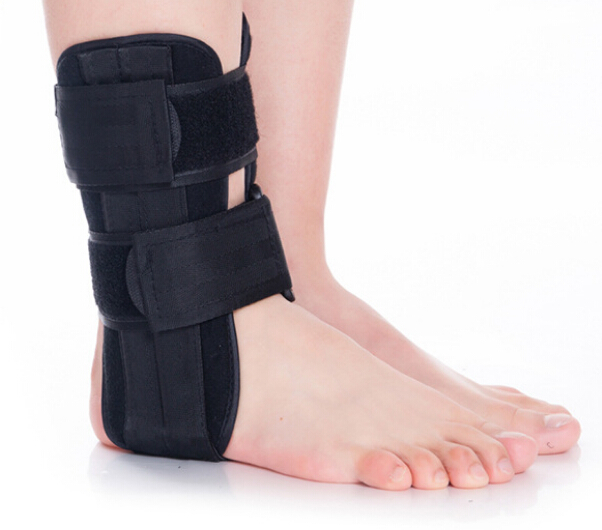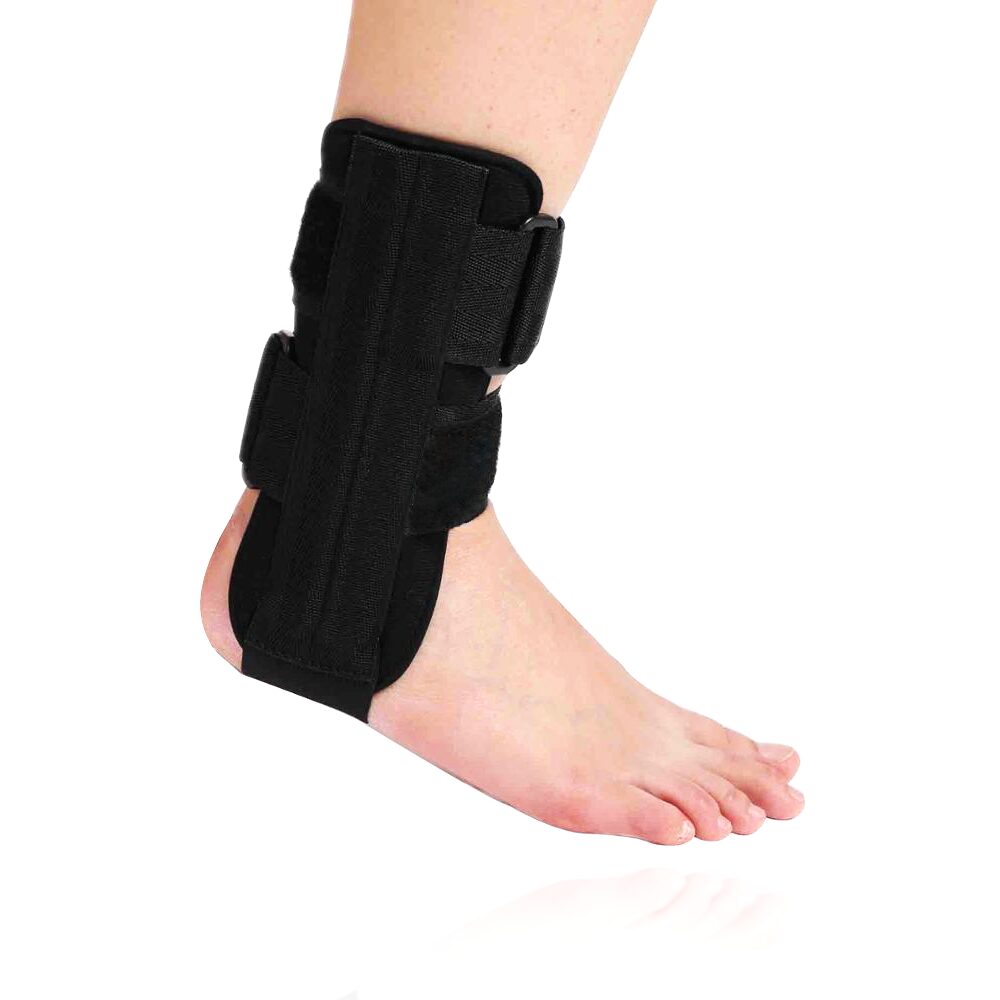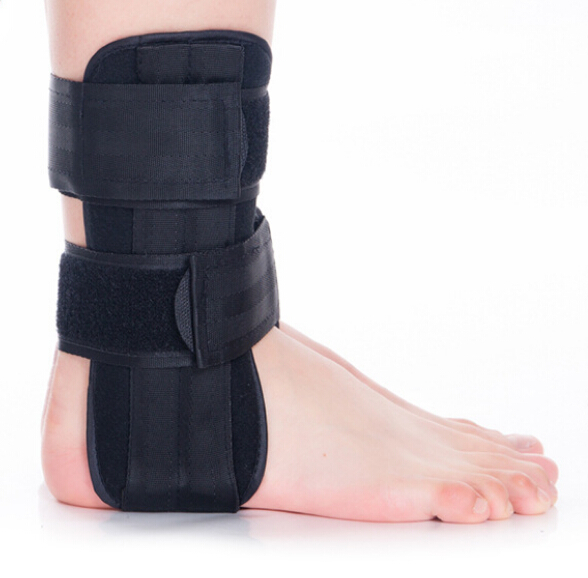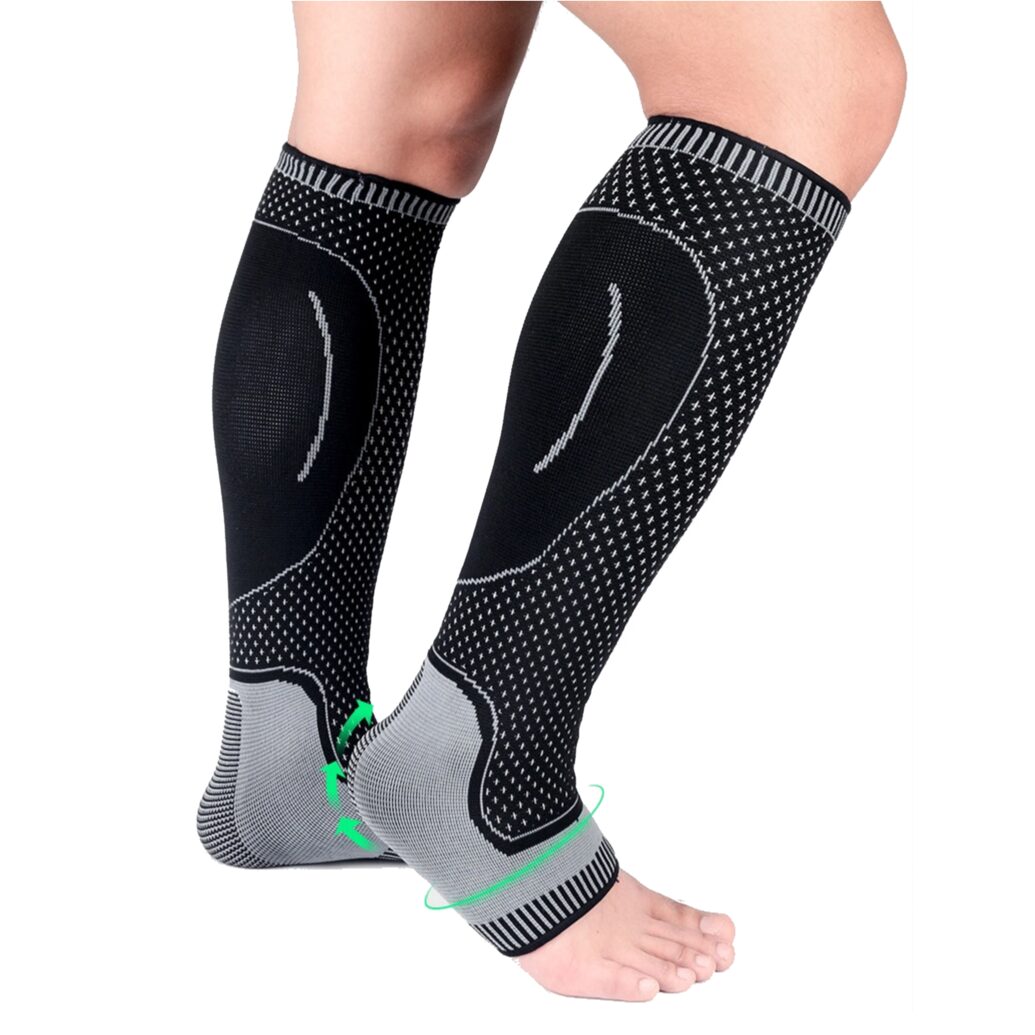No products in the cart.
Ankle Stabilizer Splint
£12.49inc VAT
- 1x FootReviver™ Ankle Stabiliser Splint, developed by foot‑care experts to provide targeted external support that helps limit risky ankle motions and ease day‑to‑day discomfort from sprains, strains, and related issues
- Three sizes (Approx. UK shoe size): Small 3–5, Medium 5–8, Large 8–11; designed to fit either the left or right ankle
- Two adjustable Velcro straps wrap fully around your ankle for a quick, secure fit and easy fine‑tuning of both hold and compression
- Two metal side stays and a contoured heel cup guide a smoother, controlled range, helping reduce side‑tilt “rolls” and sharp end‑of‑step jolts
- Unified wrap‑around control: the full‑wrap straps, side stays, and heel cup create a stable 360° hold so the rearfoot and ankle move together for steadier steps on uneven ground
- Gentle, even compression helps manage activity‑related swelling (oedema) and support soft tissues; as swelling settles, stiffness often eases and steps feel more secure
- Soft, cushioned, non‑slip lining spreads pressure and helps keep the splint in place, reducing hot spots, slippage, and the need for mid‑day adjustments
- Low‑profile, shoe‑friendly design fits comfortably in many everyday shoes and trainers; smooth edges and an ankle cut‑out reduce rubbing for practical all‑day wear
- Quick on/off without awkward twisting thanks to wide openings and easy pull tabs—handy when alternating between activity and rest
- Light warmth helps ease post‑rest stiffness, while breathable panels promote airflow to keep skin drier and more comfortable during longer wear
- Often used to support management of:
- Acute and longer‑standing ankle issues: sprains, strains, chronic instability, and activity‑related swelling
- Tendon and soft‑tissue problems: Achilles, peroneal, posterior/anterior tibial tendinopathy; plantar‑fascia‑related symptoms
- Joint, heel, and nerve conditions: ankle arthritis, synovitis, impingement, osteochondral lesions of the talus (OLT), heel bursitis/Haglund’s, and tarsal‑tunnel symptoms
- For fractures, dislocations, tendon rupture, and post‑operative care, use only on your doctor’s advice
- Suitable within a Protect‑Optimal Loading‑Ice‑Compression‑Elevation (POLICE) approach after injury, helping you maintain safer movement and avoid setbacks
- Durable build with simple care: hand wash with mild soap, rinse well, and air dry away from direct heat; check straps and supports regularly for wear
- 30‑day satisfaction guarantee for peace of mind—if it isn’t right for you, return it for a refund
Get 15% off - When bought together with:
- This item: Ankle Stabilizer Splint(£12.49inc VAT)
- Calf Support Compression Sleeves(£9.99inc VAT)
Struggling with ankle pain, stiffness, or instability can hold you back at work, at home, and when you’re active. Whether you’re recovering from an injury, managing a long‑standing problem, or following post‑operative guidance, daily discomfort is hard to ignore. The FootReviver Ankle Stabiliser Splint is designed to provide targeted external support so you can move with more control and less worry.
This stabiliser is designed to limit risky movements while holding your ankle in a steady, comfortable position. By gently guiding alignment at the ankle (talocrural joint) and the joint beneath it (subtalar joint), it helps reduce strain on key ligaments and tendons. The result is steadier steps and fewer painful jolts on uneven ground, helping you return to everyday activity with more confidence.
With two adjustable Velcro straps that wrap around your ankle, two metal side stays, and a supportive heel cup, you get practical protection you can fine‑tune to your day. A soft, cushioned lining is designed to improve comfort for longer wear. If you’re ready to reduce pain, protect healing tissues, and feel more stable, this is a straightforward way to support your ankle and improve day‑to‑day comfort.
How an Ankle Stabiliser Splint Works
Support and stability
An ankle stabiliser splint guides motion so the joint moves in a safer, more controlled arc. In this design, two metal side stays help curb excessive inversion and eversion (side tilt), while two adjustable Velcro straps that wrap around your ankle check end‑range bend (plantarflexion/dorsiflexion). A contoured heel cup helps centre the heel beneath the leg, supporting smoother tracking at the talocrural and subtalar joints. Together, these elements make the ankle feel steadier underfoot and less prone to “rolling” on uneven ground.
Smoother loading and controlled movement
By combining firm side control with a soft, cushioned lining, the splint spreads pressure more evenly and takes the edge off small jolts without blocking useful movement. This controlled range helps reduce sharp pressure spikes at the end of each step, which can otherwise provoke pain in sensitive tissues. The aim is simple: more predictable motion and easier, more comfortable walking and standing while symptoms settle.
Compression for swelling control
The two adjustable Velcro straps apply gentle, even compression around the ankle to help manage activity‑related swelling (oedema) and support soft tissues. As swelling settles, stiffness often eases and joint position sense (proprioception) can feel clearer, making steps feel more secure. Used within a Protect‑Optimal Loading‑Ice‑Compression‑Elevation approach, this kind of adjustable compression supports steady progress and helps reduce flare‑ups that interrupt recovery.
Situations Where an Ankle Splint Can Help
Daily activities
If ankle pain or instability affects your routine, wearing the splint for everyday tasks—running short errands, using stairs, or standing at a counter—adds welcome support. By limiting risky movements and providing steady compression, you get fewer painful jolts and less swelling later on. Everyday jobs feel more manageable while you work through your recovery programme.
Sports and exercise
When you start being active again, the splint is designed to help by restricting inward/outward tilt and supporting the heel. This lowers the chance of another “roll” during changes of direction and landings. Because stability is improved, you can follow a step‑by‑step plan to increase activity—such as light jogging on flat paths, gym work, or non‑contact drills—with more confidence. Always follow your doctor’s advice on when to resume sport and how to progress.
Post‑operative recovery
After surgery, the ankle can be sensitive to swelling and over‑stress. This splint provides controlled support, adjustable compression, and a secure heel cup to guide comfortable, assisted movement when your doctor says it’s appropriate. Early, safe steps—like short indoor walks—are easier as you move from immobilisation to functional support. Post‑operative use should follow your treatment plan, including any limits on movement or positioning.
Conditions and Injuries Treated with Ankle Splints
Below, we’ll explore the conditions and injuries an ankle stabiliser splint can help manage—such as sprains, synovitis, tendinopathy, chronic instability, and osteochondral lesions—showing how targeted support can make symptoms easier to live with while you recover.
Discover the FootReviver™ Ankle Stabiliser Splint
Developed from years of experience in physiotherapy and foot biomechanics, the FootReviver™ Ankle Stabiliser Splint is designed to support safer movement, reduce risky ankle motions, and make day‑to‑day walking more comfortable while you recover. Two metal side stays, two adjustable Velcro straps that wrap around your ankle, and a contoured heel cup are designed to work together to steady the joint where it needs it most—without bulky weight or complicated fittings. It brings stabilisation, compression, and rearfoot alignment together in a practical, shoe‑friendly design you can wear through your day.
Key Features of the FootReviver™ Ankle Stabiliser Splint
Targeted stabilisation that supports natural movement
This splint is designed to provide firm, reassuring control without feeling restrictive. Two metal side stays help reduce excessive inversion and eversion (side tilt), while the structure of the splint guides the ankle through a smoother, more predictable arc. You keep the motion you need for walking and stairs, but with fewer twists and jolts that tend to provoke pain. In everyday terms, turning, stepping off a kerb, and moving across uneven paths feel more controlled, so you can get on with your day with greater ease and confidence.
Contoured heel cup for aligned, confident steps
The deep, shaped heel cup seats the heel squarely beneath the lower leg, encouraging steadier rearfoot alignment and a cleaner subtalar track. With the heel held consistently, ankle motion feels smoother and less wobbly—especially when you change direction, turn in tight spaces, or step off a kerb. This steady base also makes balance work and careful outdoor walking feel more consistent. By reducing unwanted heel drift, the splint helps limit the small, repeated irritations that can build up during daily movement.
Two adjustable Velcro straps for a secure, personalised hold
Two adjustable Velcro straps wrap fully around your ankle so you can fine‑tune both hold and compression in seconds. When a task feels less stable—using stairs, crossing a cambered path, or turning on uneven ground—tighten the straps for a firmer, more supportive feel. During quieter periods, ease the tension to reduce pressure on tender areas. Because the strap paths are clear and easy to repeat, you can achieve the same reliable fit without over‑tightening. That means dialled‑in support you can adapt through the day for comfort and control, without fuss.
Unified 360° hold for coordinated foot‑and‑ankle control
Building on that personalised fit and the steady rearfoot base from the heel cup, the same full‑wrap straps work together with the two metal side stays to create a continuous 360° hold around the joint. This unified support helps the rearfoot and ankle move as one through a stable, guided range, limiting sharp inward/outward roll and abrupt end‑range bend that can trigger symptoms. Motion feels more coordinated and repeatable—especially during starts, stops, and gentle changes of direction—so the foot stays better anchored beneath the lower leg and steps feel more consistent on uneven ground.
Smoother loading for easier steps
The two metal side stays provide firm side control while the soft, cushioned lining helps spread pressure, taking the edge off small knocks without blocking useful movement. By smoothing how load passes through the ankle during stance and push‑off, the splint helps reduce sharp pressure spikes that can flare symptoms. Everyday time on your feet—running short errands, standing during brief trips, or taking a steady outdoor route—typically feels easier and less tiring. You get reassuring control that protects sensitive areas while still allowing comfortable, natural motion.
Non‑slip inner lining for consistent support
A softly grippy inner lining helps the splint stay where you set it, so support doesn’t drift as you walk. Less slippage means fewer adjustments during the day and less need to pull the straps overly tight—reducing the chance of hot spots or pinching. Because the position stays consistent through your stride, the stabilising effect remains steady from morning to evening. Around the home, on stairs, or outdoors at a measured pace, you get a steady, secure feel that makes movement more confident and less taxing.
Low‑profile, shoe‑friendly design for everyday wear
The slim profile and smooth edges are made for daily life. The splint fits comfortably in many everyday shoes and trainers without feeling bulky, while a shaped cut‑out reduces rubbing around the ankle bones. Stabilising components are positioned to give firm control without pressing on sore spots. The practical outcome is simple: support you can actually wear for longer stretches—during commuting, errands, and indoor tasks—helping you stay active and consistent with your recovery programme while keeping irritation to a minimum.
Quick on/off without awkward twisting
Wide openings and easy pull tabs make the splint straightforward to put on and take off while keeping your ankle in a safer position. That matters when you’re alternating between short walks, rest, and specific exercises: you get the support you need without wrestling with a tender joint. Once fitted, the simple strap layout helps you recreate the same secure hold in a few quick steps. It’s an efficient routine that saves time and lets you focus on moving comfortably throughout the day.
Gentle warmth to ease stiffness
The supportive body gently retains warmth around the joint, which can help ease that stiff, post‑rest feeling and make first steps more comfortable. Warm tissues often feel more supple, so controlled movement tends to feel smoother and less jarring—especially in cooler conditions or early in the day. Paired with the stabilising hold, this gentle warmth helps you settle into a steadier stride sooner, so everyday tasks—like getting going in the morning or after sitting—feel less daunting from the start.
Breathable, moisture‑managing materials
Breathable panels promote airflow to help keep skin drier during longer wear, while smooth contact surfaces reduce friction around sensitive areas. This combination supports lasting comfort—useful when the splint sits inside shoes or during stop‑start activity—without the clammy build‑up you can get with less breathable supports. The aim is straightforward: day‑long wearability you barely notice, with reliable control you can feel when you need it, so you can keep the splint on through your routine without distraction.
Durable construction and simple care
Built for repeat daily use, the splint is designed to hold its shape and supportive feel over time. Care is simple: hand wash with mild soap, rinse well, and air dry away from direct heat. Avoid tumble drying, bleaching, or wringing. Check the straps and support elements regularly and stop using the splint if you notice fraying, cracking, or a misshapen frame. With minimal maintenance, you can rely on steady, consistent performance day after day while you work through recovery.
Sizing and fit
For an accurate fit, measure around your ankle at the narrowest point just above the ankle bones (malleoli). The splint should feel secure but not tight. If you fall between sizes, choose based on your priority—a closer hold for more control or a slightly roomier fit for greater comfort. After fitting, walk for a minute and re‑check the straps so the hold is snug and even without pinching. Designed to fit either the left or right ankle.
30‑day satisfaction guarantee
We want you to feel supported and comfortable. If the splint isn’t right for you, a 30‑day money‑back guarantee allows you to return it for a refund—simple and straightforward.
Important Health Information & Disclaimer
This information is general and does not replace medical advice, diagnosis, or treatment. Ankle problems vary widely, and only your doctor can assess your needs based on your history, examination, and goals. The FootReviver™ Ankle Stabiliser Splint is a supportive aid for day‑to‑day use; it is not a rigid immobiliser or a night splint. It should be used as part of a wider plan that may include changes to activity, specific exercises, and other treatments recommended for your condition.
Before using any ankle support, speak to your doctor if you have a recent injury with severe pain or deformity, cannot take four steps, or suspect a fracture, dislocation, tendon rupture, or major ligament tear. You should also seek advice if you have diabetes, reduced sensation, circulation problems, inflammatory or crystal arthritis, or a history of delayed wound healing. Signs of infection—intense heat, marked redness, fever, or feeling unwell—require urgent assessment.
Safe use means a secure, even fit that does not restrict circulation. Apply the splint while seated, guiding the heel into the cup without twisting the ankle. Fasten the straps so the hold is firm and comfortable. Check your toes after fitting; if they become unusually cold, pale, tingly, or numb, loosen or remove the splint. Build up wear time gradually, starting with shorter periods for walking and light activity. Remove the splint daily to inspect the skin, especially around the heel, Achilles, and ankle bones, and avoid wearing it in bed unless your doctor specifically advises this.
Stop using the splint and seek advice if pain worsens, new numbness develops, swelling increases despite relative rest, or you notice skin damage or pressure areas that do not settle. If your walking becomes more unsteady or you develop new pain in the knee, hip, or back, arrange a review—changes in your gait can shift load higher up the body.
Good care helps preserve both comfort and support. Hand wash with mild soap, rinse well, and air dry away from heat. Do not tumble dry, bleach, or wring. Inspect the splint regularly for frayed straps, cracked stays, or loss of shape. Replace the splint if parts are damaged or if it no longer provides a stable hold. Used alongside a clear treatment plan, the FootReviver™ Ankle Stabiliser Splint is designed to help you move with more control and comfort while you recover.
2 Reviews For This Product
Fast & Secure Checkout Through Paypal
Pay with Paypal the secure payment gateway that accepts all credit and debit cards. Paypal is free and secure and no credit or bank information is ever stored or shared with us.
Fast Dispatch
Enjoy your items soon with quick dispatch via Royal Mail First Class. Expect to have your items between 1-3 days for domestic orders. 7-10 Working days for international orders.
Return Policy – 30 Day Money Back Guarantee
We are so confident that you will just love our product that we offer a full 30 day money back guarantee. In the unlikely event, you are unhappy with your purchase you can simply return it within 30 days for a refund. Please contact us via the form on the contact us page to start your return.
To return an item please send it to: Nuova Health UK, 81 Highfield Lane, Waverley, Rotherham, S60 8AL. Please include a note with your order id so we know who to refund. Please retain your postage receipt as proof of postage. All that we ask is that the item is in the original packaging and unused.






by Andrew
Bought this after spraining my ankle and it has really helped support and strengthen my ankle up again. Would 100% recommend!
by Elly
After a minor ankle sprain, I decided to give the Ankle Brace a whirl. It’s been a revelation! The quality is stellar and it’s made my recovery a breeze. Absolute thumbs up!